*Just make sure you get the go-ahead from your PT or physician before undertaking a stretching routine.
You will find stretching exercises helpful for your tendonitis recovery if:
Gentle stretching and exercise not only helps you to recover or maintain your range of motion when recovering from an injury, but in unfortunate cases when surgery is required, it is often recommended both before and after undergoing surgery. Surgeons will sometimes recommend a pre-surgery plan that includes specific exercises to prepare your joint for the surgical procedure. After surgery, stretching is recommended again as part of your rehabilitation from the surgery recovery process. At that stage you will probably meet with a PT to learn proper exercising techniques.

Exercising focuses on enhancing the flexibility of soft tissue - muscles, tendons and ligaments in your affected area, while also strengthening surrounding soft tissue. In the body, all things are connected. So when you are trying to heal a soft tissue injury you will need your surrounding (non-injured) muscles, tendons and ligaments to be strong and healthy too. This is because the surrounding soft tissue will help distribute the weight of carrying or reaching while you recover from your injury.
The most amazing thing about stretching is that the benefits of this can be greatly enhanced by pre-warming the soft tissue areas that will undergo stretching by the application of a TShellz Wrap®.
Your body uses your blood supply to heal. Even if you don't receive enough blood flow to the location of your tendon injury, you can still treat yourself in a way that gives your natural blood flow the boost it needs to reach further into your torn or strained tissue. Luckily the application of a TShellz Wrap® not only warms up soft tissue, it also boosts blood circulation in the area where it is applied.
Working with your blood flow is an easy process that can be made even easier with the treatment tools available from AidYourTendon.
Joint Atrophy is arguably a bigger issue than even scar tissue. Whether you have a chronic tendon injury or have recently had an operation, you will find that your joint has a more limited range of motion than you had before. In most cases, this is due to atrophy - the shortening of connective tissue in the joint due to inactivity. In cases where atrophy exists, it is very important to stretch and do gentle exercise to nip this problem in the bud before it becomes a chronic (long-lasting) issue. If you are currently recovering from a chronic injury speak with your physician about stretches and exercise.
Stretching is an important part of most injury recovery processes though timing is everthing. This is why it is important to consult with your physician or PT before initiating any form or exercise or stretching after a soft tissue injury. Stretching has been known to aid in the increase of healthy blood flow circulation, flexibility, and range of motion - all of which help to decrease your pain and speed up in the natural healing process of your soft tissue.
When you stretch and hold a stretch, the action of stretching lengthens your muscles, tendons and ligaments. Movement of any kind is an essential part of recovery from a torn or strained muscle or tendon, rehabilitation after soft tissue surgery, or managing on-going pain from injury, re-injury or degenerative conditions (like arthritis and osteoarthritis).
There are a lot of misconceptions about stretching - like how to stretch, when to stretch and how long to hold the stretch. In some ways, your stretching can be completely ineffective if you aren't following some very basic guidelines during your stretch. Improper stretching can also lead to more pain, re-injury or even more worsen your tendon injury. Stretching is such a vital part to recovery, but the idea that "any stretching is good stretching" is completely wrong. If you aren't going to take the time to stretch properly, speak to your doctor, meet with a health professional, learn what stretches will help your condition and the techniques to properly stretch then you aren't involved enough in your own injury recovery process.
Here are the questions you need to ask yourself in order to determine if your stretching will actually help in your soft tissue injury recovery process:
Learning these details will help you in making sure that your rotator cuff exercises will have a long-lasting positive impact on your recovery process.
One of the most common mistakes people make when stretching is thinking that you're supposed to stretch before initiating activity. If you're not an athlete then you might know about "cold" stretching and may be doing this every time before your workouts.
"Cold" stretching is basically doing static (non-moving) stretches before getting active. it is thought that stretching before activity will loosen up your muscles, warm up your tissue and get your circulation moving. Everything you may have thought about this is wrong. Stretching right away without a proper warm up can actually decrease your strength, power and performance. (reference: https://www.webmd.com/fitness-exercise/features/new-ideas-on-proper-stretching-techniques accessed Jan 2023)
Static stretching can be harmful to your body if you aren't warming up properly first. Doing static stretching on "cold" soft tissue (that has not had a chance to warm up) will be forcing your tissue to lengthen and extend and will only tighten up your injury tissue further. Some studies have found that static stretching without a proper warm up will actually decrease muscle strength by 30%. Your tissue may even stay in a weakened state for 30 minutes after your stretching. Now it's obvious to see why for these reasons you should be properly warming up your soft tissue before stretching - and the best way to do that is to increase your blood flow to increase oxygen intake to your muscles, tendons and ligaments. (reference: http://www.nytimes.com/2008/11/02/sports/playmagazine/112pewarm.html?_r=0).

Moving or bouncing your limb while stretching in a static (unmoving) pose can actually do you more harm than good. Bouncing into stretches can cause tearing in your joint (muscles, tendons, ligaments) that will lead to the growth of more scar tissue in the area. This scar tissue will further tighten the area making any movement or activity even harder.
It's important that you keep a still position when stretching an injury to make sure that the stretch is benefiting your injury instead of making it worse.
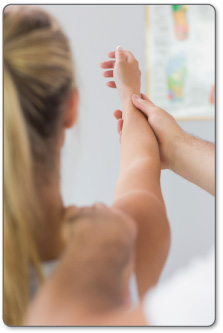
Holding your stretch for 30 to 60 seconds is important to actually gain benefit from the stretch being performed. Stretching for less than 30 seconds will not provide a difference in flexibility or lengthening the soft tissue in your rotator cuff (muscle, tendon, and ligament fibers). Stretching for more than 60 seconds can tighten and stiffen your joint because you're leaving your tissue in a fully contracted or extended position which will result in lack of circulation in that specific joint.
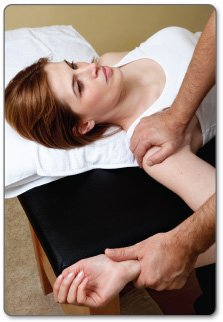
Rotating or raising your limb too far into a stretch can also be harmful to your recovery process. If you feel pain at all when stretching you are most likely going too deep into the stretch and attempting to extend your joint range of motion too far. In some cases, your joint (shoulder, knee, elbow, etc.) might start to fight against your stretch, which is a natural muscle response. Muscles have memory and they know the range of motion that's safe for your to go into and hold a stretch. If you try to stretch beyond that natural range of motion your muscles will try to stop the stretch and push back against your efforts.
After stretching your soft tissue you need to increase blood flow circulation and treat any new micro-tearing in your rotator cuff. This is when a proper "cool down" is essential to make sure that your tissue is receiving enough oxygen by increasing your blood flow. This can be done easily by applying cold to your tissue after stretching. Cold will bring blood flow away from your arms and legs to centralize it into the core of your body near where your injury is. Increasing blood flow is a quick and easy way to supply the much-needed oxygen to your tissue. Cold applied at this time will also nip any swelling or inflammation in the bud so you won't feel the pain and swelling that usually comes with new tissue damage.
Stretching can only do so much to help you recover from your tendonitis. If you're attending PT clinic appointments then you'll soon see that PT only gives you a small amount of time (a few weeks) to recover from a muscle, tendon or ligament injury. Even if you have surgery, you'll only get a few weeks of PT for post-op rehabilitation. It's important that you understand that a short time at PT with on-going stretching under the guidance of a medical professional can be helpful, but it's merely the beginning of your journey.
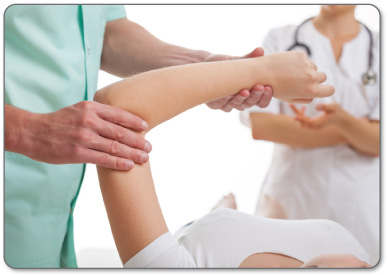
Stretching is important, but what should you be doing to make sure that your stretching is having a lasting impact on the recovery of your tendinitis?
For most people suffering from a significant soft tissue injury - especially chronic tendonitis, exercise is only the beginning. In order to fully recover you need to augment your recovery with conservative treatment methods done at home on a daily basis. Continuous movement and stretching is the only way to regain range of motion in your joint and prevent atrophy (wasting away) of your muscles and tendons. What truly makes a difference to your overall injury recovery and rate of healing is your commitment to a long term recovery plan that includes regular stretching and use of conservative treatment tools at home.
Ask any doctor and they'll tell you that the success of your soft tissue injury recovery and/or surgery depends on your level of dedication to regular at home care of your injury. The best way to add to your exercising at home (and any stretching under the guidance of a medical professional) is use of conservative treatment tools that will help you to "warm up" and "cool down" your tissue. This requires an increase in blood flow before stretching and a decrease in any pain and swelling after stretching.
The only way to increase blood flow on your own is through cardio, aerobic activity, or continuous movement. This might sound easy to do before your injury, but can be difficult to achieve when you are in a lot of pain. So what do you do when you need to warm up your tissue before exercise but you can't move your injury?
This is where use of conservative treatment tools, like a TShellz Wrap, can boost your blood flow without having to move your already injured joint. A TShellz Wrap will provide Circulation Boost that increases the elasticity of soft tissue. After stretching, effective cold compression with a Cold Compress will have a major impact in subduing the swelling in and around your soft tissue injury while dealing with any new tissue damage caused by your stretching. Cold compression during your "cool down" will also naturally relieve much of the swelling induced pain caused by stretching (especially if you have over-stretched or deepened the stretch too much).
Using these treatments (on a regular basis, as suggested in the product instructions and under the guidance of your doctor) will boost the effectiveness of your stretching (providing long-lasting benefits), and lessen the chance and/or severity of joint degeneration, muscular atrophy, re-injury or other soft tissue pain during your recovery process.
Part of recovery is building a plan for successful healing that includes 3 essential elements: a warm-up, stretching and a cool down. This 3-step approach is also used in clinic settings. It's a process that provides the best results and impact of your stretching.
For this 1st step many PTs will use heat, manual manipulation, deep tissue massage, clinical ultrasound devices or a warm bath to warm up your injury area and the entire joint. The goal during this first step is to increase healthy blood flow circulation and relax your soft tissue. Warming up the area will increase the elastic nature of your tendons, ligaments, and muscles, making it much easier to stretch, and when needed, hold the stretch. This will also extend the amount that you will be able to stretch your affected joint.
Use a TShellz Wrap for 15 to 20 minutes at least half an hour before your exercises. A TShellz Wrap will promote blood flow to your rotator cuff tear while warming up and relaxing your injured tissue. This is intended to make your muscle, tendon and ligament fibers more elastic and pliable, allowing for more ease of movement when you're stretching.
Proper stretching of your affected joint is meant to increase range of motion and strengthen all of the supporting tissue in the injured area. When stretching it's important to also develop the surrounding muscles as they will be taking on some of the work that your injured tendon can't handle. Strengthening your entire area will also give you a better chance of slowly improving the mobility of your joint. This injured soft tissue will only be as healthy and pain free as you make it with doing your daily stretching exercises. Gaining back your mobility is critical to developing a healthy joint.
Toward the end of your appointment your PT may introduce cold compression, acupuncture, or TENS to relax your injury site after intense stretching and exercise. We recommend the use of a Cold Compress after stretching, or whenever you feel sharp pain. The Cold Compress will relieve any on-going pain and swelling while preventing full-blown inflammation from returning after your stretching. Using the Cold Compress after stretching will help remove inflammation and help remove constrictions that limit blood flow in the affected joint. This allows the recently stretched soft tissue to get better access to oxygen and nutrients in the bloodstream and help remove lactic acid builup - sorely needed when recovering from exercises and stretches.
Start with a 20 minute treatment directly after stretching and apply more cold compression whenever you need to relieve pain and inflammation in your injury area.
Constant re-injury (you know when it's happening, you can feel the pain) needs to be avoided at all costs. Obviously, it delays the healing process, but what's worse is that every re-injury and additional healing cycle increases the amount of scar tissue that builds up in and around your rotator cuff injury.
Scar tissue is hard, inflexible, and tough to get rid of. The more severe your injury is, the more likely that this scar tissue will fill into the tears in your soft tissue, also attaching to all of the surrounding healthy tissue. This added scar tissue will restrict your ability to control the movement of your joint. Scar tissue also makes the affected area much more prone to injury again later on as scar tissue is inflexible. The more scar tissue that develops, the more you lose the range of motion in your entire joint.
Continuous re-injury and build-up of scar tissue while staying active means you'll have a greater chance of winding up with on-going pain, more tearing in your joint and tearing or weakening (atrophy) of surrounding tissue (ligaments, tendons, muscle).
If you have pain and inflammation, it's very important to heal your injury quickly and completely. You must avoid the build up of scar tissue. If you don't, your injury may become chronic and plague you for years. This is why it's so important to continuously use conservative treatment tools to heal any recurring soft tissue damage before it can build into something big. For any tendonitis, tendon tear or tenosynovitis sufferer, having the right tools means all the difference.

Everything in the human body is connected. Any soft tissue injury can lead to other injuries over time if not treated properly. If you have bicep tendonitis in the upper arm/shoulder for example, you might start lifting with and using your opposite arm when performing normal daily activities, like brushing your teeth, brushing your hair, carrying or reaching for things. You may also try to rely on your opposite (healthy / stronger) shoulder and arm to get yourself back to work, activities or your sports sooner to avoid waiting for your original tendon injury to heal completely.
For shoulder tendonitis, many of our clients have experienced pain in the affected arm's elbow and their opposite elbow or shoulder because they shift their lifting weight and use to the opposite arm. For example, you might normally reach for items off of higher shelves with your right arm, but instead will use your left arm while your right arm heals. Even though changing something like this seems like a really small thing, changing the way you would normally reach and grab for things when your body isn't used to that can result in pain and injuries in your healthy arm. For sufferers of hip or knee tendonitis, the often experience overcompensation pain in the lower back and opposite knee.
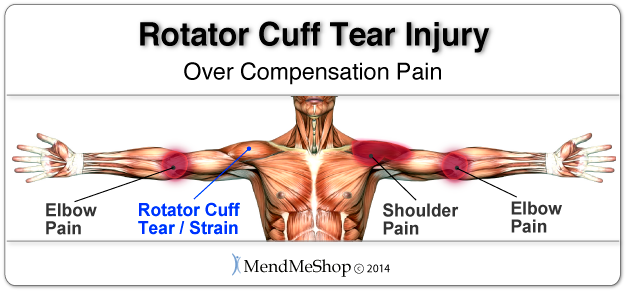
Over time you'll notice that you automatically start to put more weight on your non-injured side to cope with everyday activities. When you experience pain on the opposite side of your body, this is something called "over compensation" pain. Usually, an initial injury will occur on the dominant side (if you are right handed, this would be your right shoulder/elbow/knee/wrist). When this happens there is a higher risk that you'll over-strain your weaker side that's compensating for your injury, because it's just not as strong as your dominant side.
LEC Response® through the use of a T•Shellz Wrap when combined with passive stretching is, in our opinion, the best home conservative treatment option available to deal with over compensation issues by maintaining healthy blood flow to the entire affected area.
Even if you try to avoid over compensation pain, you're still at risk for re-injuring the original injury. Ignoring over compensation pain and the pain felt from your soft tissue injury while returning to regular activities or your job can lead to even more problems with healing.
If you have a torn tendon or a suffering from tendonitis or tendinosis, it's very important to heal it quickly and completely. Minimizing the healing time should be an obvious goal, as a chronic tendon injury will limit your ability to go about your daily routine for a long period of time.
A seemingly small, nagging tendon or muscle injury that's not properly treated can lead to a chronic painful degenerative joint injury that can persist for months or even years if not properly treated.
For conservative treatment of pain and swelling in soft tissue - even after surgery, get the swelling down to "open up" the area for more blood flow. Anyone in the health-care business knows that your blood supplies the oxygen and much needed nutrients required for your body to heal naturally after surgery. This is why doctors and surgeons recommend cold compression within the first 72 hours of an soft tissue injury and/or following surgery.
Cold compression is recommended to reduce pain, swelling and tissue damage. Many doctors, surgeons and PTs consider cold compression to be the gold standard for treatment of inflammation and pain. On-going cold compression treatments can reduce, or even eliminate, the need for NSAIDs or other medications that can be harmful to your body.
Cold compression is known and trusted by most medical professionals. This is why for years doctors, trainers and other medical professionals have recommended RICE (Rest, Ice, Compression, Elevation) to treat the pain and swelling of fresh injuries, chronic pain, after any re-injury, and especially after surgery.
There are a lot of people that think their tendonitis is gone after swelling and inflammation is gone and they start feeling better. They also make the mistake of returning to regular activities too soon without proper time for healing. The truth is that healing takes time and after the swelling is gone your tendon or muscle injury isn't fully healed.
After inflammation has been reduced, providing extra blood flow and strengthening the tissue in your soft tissue injury is recommended. Believe it or not, the best time for you to focus on avoiding re-injury and strengthening the weakened tissue is when the swelling is gone. It's vital that you don't go back to activities too soon because chance of re-injury is high while your soft tissues are still weak. It is a common problem for tendonitis sufferers.
Most people we deal with tell us these scenarios have happened to them many times in the past. The real challenge is how to promote blood flow to your injury without causing further damage. This goal is even more complicated by the fact that you have to use your arm for almost everything in everyday life.
The answer is simple. Your body can heal itself and it's the blood in your body that makes it all happen. Your blood is how everything that's good inside of you is transported directly to your injured rotator cuff. Your blood carries oxygen, nutrients and water right to the source of your injury and pain. Bringing proper blood flow to your soft tissue injury is essential for healing.
Promoting blood flow around injured tissue to help the body heal itself is a concept that's been used for centuries. Oxygen and nutrients, carried in your own blood, are critical for the body to heal itself. Without proper blood flow, recovering from your injury or tissue tear will be delayed... Sometimes for a very long period of time.
Even though the concept is simple, improving blood flow to the tendons and ligaments in your shoulder can be difficult. Traditional methods require you to move your injured joint in order to promote blood flow. This same motion that promotes blood flow can also make your pain and injury much worse (especially if you need to immobilize the area during surgery recovery). Relying on movement alone to increase blood flow puts you in serious danger of re-injury.
So what do you do when you need to increase blood flow, but you can't move the limb without re-injuring your tissue? This is where the TShellz Wrap® comes in.
Using a TShellz Wrap® increases the amount of blood that flows naturally, while simultaneously heating tissue in the area. Increased blood flow boosts the body's ability to heal, while the heat helps elongate and increase elasticity of tissue in the area. Increased blood flow to damaged tissue is greatly needed to complete the healing process, while the elongated and more flexible tissue help temporarily reduce risk of re-injury which can become a major setback to the recovery process.
Regular treatments with a TShellz Wrap can reduce pain and stiffness from scar tissue and increase overall flexibility in your arm. Increased blood flow will whisk away damaged tissue, toxins, and any bacteria in or around your soft tissue injury to promote more effective healing. Getting rid of toxins will allow all of the positive healing processes to work more quickly. Increasing blood flow will also increase the amount of oxygen that's being sent to your injured tissue AND boost your tissue's ability to absorb oxygen. (reference: 1)
TShellz Wraps® contain a unique Carbon Fiber Energy Pad which is flexible and will shape to conform to your body. This Energy Pad emits a uniform wave of perfectly safe energy over its entire surface. This energy is absorbed by soft tissue in the treatment area, opening blood vessels, resulting in an increase in blood flow. Increased blood circulation is what your body needs to accelerate the healing of soft tissue and this is why we recommend the TShellz Wrap®.
The TShellz Wrap® is an FDA Registered Medical Device and is suitable for use in therapeutic clinics and FROM HOME. It is completely safe for people and patients to use for themselves.
The technology found in a TShellz Wrap® has been used for decades in the worlds of professional and amateur sports - a contributing factor as to why athletes seem to recover from injuries so quickly.
Have you ever wondered by an athlete can return to activity after 3 or 4 weeks following a soft tissue injury - while your average person takes much longer to return back to normal? The secret isn't really that much of a secret - it involves consistent treatments (meaning multiple times a day) using a treatment like the TShellz Wrap® to stimulate blood flow to the injured tissues. Most athletes have the luxury of using in-house facilities many times per day.
How many us can afford the time and money to visit a clinic multiple times a day? Very few indeed. This is how you can gain some of the advantages that athletes enjoy in their injury recovery - by using a device like the TShellz Wrap® two or three times a day on a consistent basis.
We believe the TShellz Wrap® to be one of the most effective home treatments to increase localized blood flow in and around the treatment area.
We can promise that you will receive a product that is designed to be safe and does what it is supposed to do... reduce pain (as stated in "Therapeutic Heat and Cold", 4th edition. - Ed. Justus F. Lehmann, M.D., Williams, and Wilkin) temporarily increase length & flexibility of soft tissue (as stated in "Therapeutic Heat and Cold", 4th edition. - Ed. Justus F. Lehmann, M.D., Williams, and Wilkin) and aid your body in recovering from tendon, muscle and other soft tissue injuries via enhanced blood flow.
The unit plugs into a standard wall outlet to get its power. The nice thing about the power supply is that the same unit can be used in North America and overseas as well. It has the capability to operate between 110v and 230v.
The TShellz Wrap® has a special signal controller that can be set for 3 different power levels of application (3=High, 2=Medium, 1=Low). The cord is long enough that you can sit or lie comfortably and watch TV, read or surf the net while you're using it.
Treatments are max 30 minutes in duration and the device can be worn over clothing. This allows you to use the device at work, at home, or really anywhere you have access to an electrical outlet.
Conservative treatment tools just like these have been used successfully by thousands of soft tissue injury sufferers - just like you.
We believe the use of TShellz® Circulatory Boost Wraps for boosting blood flow to soft tissue in the area of application is one of the most under-utilized home treatment options available on the market today. We have client after client that have tried many options out there and have been amazed at how effective and fast the TShellz Wrap treatment can relieve pain and increase blood flow in the treatment area.
These tools are what you need for rapid healing. These are the tools that top professional athletes use to treat their injuries every single day. And just like these athletes, you can treat yourself at home. If you are suffering from any form of tendinopathy or you're recovering from soft tissue surgery, you can heal quickly if you treat your injury correctly. That means using the right therapies every single day.
With regular use of the TShellz® Circulatory Boost Wrap:
*Know that every personal soft tissue injury is unique and the TShellz Wrap may not work for everyone. This is why we offer a 60-day money back return on all our TShellz Wrap devices.
For acute (new or recent) tendon tears that have the ability to heal on their own - your doctor may even put a cast on your joint if the cast can keep the tendon at the level of extension that the doctor wants... or in a removable brace/splint. A removable splint can be very helpful to prepare you for PT sessions and mobility exercises.
Prolonged use of a cast, removable splint, or long-term rest (restricted movement) without proper exercise or stretching can make your Achilles tendon injury worse. If your Achilles tendon remains completely immobilized and at constant rest, the ends of the Achilles tendon (where it attaches to bone or other muscles) will begin to fill in with scar tissue as part of the healing process. You may also have on-going symptoms of pain, swelling and inflammation, and even poor blood flow circulation.
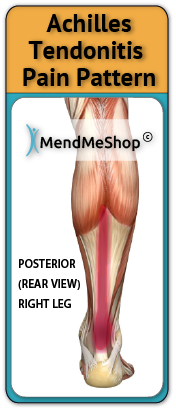
Lack of proper blood flow and growth of scar tissue will decrease the natural length of the tendon (atrophy) and tighten tissue, reducing the flexibility in the joint. Your ability to use this joint in taxing activities will become compromised. In summary, resting/casting/splinting of a compromised/injured tendon is good if done properly, but it is important to not rest it for too long as this will cause more issues related to atrophy.
Product Advisors are available 9:00 am to 5:00 pm Eastern Standard Time Monday to Friday.
I want to learn more about Post-Surgery Recovery
I want to learn more about TShellz Wrap® Circulatory Boost
I want to learn more about Ice & Heat: Which Is Better For Treatment?
I want to learn more about Tendonitis Treatments
I want to learn more about Tendonitis Surgery
During your recovery, you will probably have to modify and/or eliminate any activities that cause pain or discomfort at the location of your soft tissue injury until the pain and inflammation settle. The more diligent you are with your treatment and rehabilitation, the faster you will see successful results!
Please be aware that this information is neither intended nor implied to be a substitute for professional medical advice. CALL YOUR HEALTHCARE PROVIDER IMMEDIATELY IF YOU THINK YOU MAY HAVE A MEDICAL EMERGENCY. Always seek the advice of your physician or other qualified health provider before using any of our outstanding products to make sure they are right for you and your condition or if you have any questions regarding a medical condition. Always see your doctor for a proper diagnosis as there are often many injuries and conditions (some very serious) that could be the cause of your pain.
© 2025 In.Genu Design Group, Inc. Contact Us